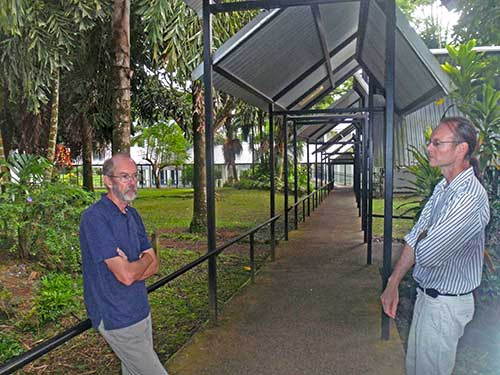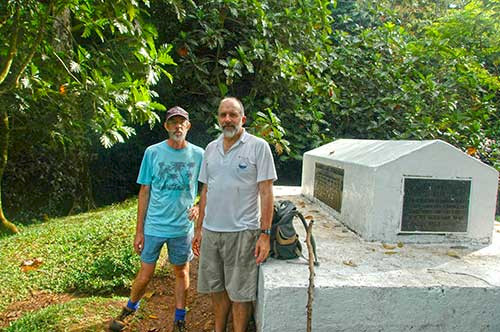A visit to the Secretariat of the Pacific Regional Environment Programme, Samoa
Bill Dennison ·At the invitation of Drs. David Haynes and Tim Carruthers, I visited the Secretariat of the Pacific Regional Environment Programme (SPREP) offices in Apia, Samoa. I had previously met David Sheppard, the Director of SPREP, when he visited Washington, D.C., but David was away on travel when I visited Samoa. The SPREP offices formed a nice campus of separate buildings, joined by covered walkways. I met with various staff, gave a seminar and had a nice lunch in town with Tim and Tepa from SPREP.

SPREP's vision is "The Pacific environment -- sustaining our livelihoods and natural heritage in harmony with our cultures". There are 25 nations in SPREP, which include 21 island nations and 4 countries with interests in the Pacific. The 21 SPREP island nations are American Samoa, Cook Islands, Federated States of Micronesia, Fiji, French Polynesia, Guam, Kiribati, Marshall Islands, Nauru, New Caledonia, Niue, Northern Mariana Islands, Palau, Papua New Guinea, Samoa, Solomon Islands, Tokelau, Tonga, Tuvalu, Vanuatu, and Wallis and Futuna. The four SPREP member countries who provide funding and resources are Australia, France, New Zealand and United States.
SPREP has about 60 staff who travel extensively throughout the Pacific, as there are over 30,000 islands that range from large volcanic islands (e.g., Fiji, Tahiti) to small oceanic atolls (e.g., Kiribati). SPREP was established in 1993 and is the primary intergovernmental environment organization in the Pacific. The four focal areas for SPREP are 1) climate change, 2) biodiversity and ecosystem management, 3) waste management and pollution control and 4) environmental monitoring and governance. Samoa was chosen for the SPREP office, as it is quite central to the member countries and very much in the heart of Polynesia.

The SPREP region includes Polynesian, Melanesian and Micronesian islands that are separated by vast tracts of the Pacific Ocean. There are offshore tuna fisheries and inshore coral reef fisheries, with tourism and some export commodities like coconut products, but the region largely relies on foreign aid and remittances (money earned by people living abroad and sent home). There are plans to begin some controversial deep sea mineral mining near New Guinea.
The discussion that we had at SPREP, particularly with Stuart Shape, who heads up the Island Ecosystem Program, was the potential for the Integration and Application Network to work with member nation staff to build capacity in environmental reporting and science communication. This collaboration would be facilitated by Drs. David Haynes and Tim Carruthers who have worked with and for IAN in the past. In addition, IAN has been engaged in capacity building in the Pacific, with trips to Palau, Philippines, Indonesia, Guam, American Samoa and Hawaii.
SPREP has an interesting diversity of personnel, with local Samoans, various other Pacific islanders, Australians, New Zealanders, Irish and Americans. SPREP personnel sign up for up to two stints of three years and live in and around Apia, Samoa. The 'Ex-Pat' community of Apia also includes embassy and consulate personnel. I was impressed with the enthusiasm and commitment that SPREP staff possess. They were knowledgeable about their subject, whether it be web sites, geographic information systems, endangered species, or hospital waste. They were busy with meetings, conference calls, video meetings that occur both early in morning and late in the afternoon, depending on the time zones involved.
One of the major challenges for SPREP is to work across the vast geographic distances and diversity of cultures in their region. The use of conceptual diagrams and incorporation of other visual elements (e.g., maps, photographs, video, and graphs) which IAN promotes would lend themselves to SPREP communication products that have such a broad diversity of audiences. The importance of establishing the broad conceptual framework for the region was also discussed. Establishing a monitoring framework applicable to the region with a sustainable approach to monitoring would also be something that IAN could help with.

The visit to SPREP was very worthwhile, as it is always better to begin a collaboration with an image of the place and people involved. I look forward to working with a group of committed individuals attempting to make a difference on such a large portion of the planet. I am reminded of one of my favorite quotes from Margaret Mead, the anthropologist who studied Samoans, "A small group of thoughtful people could change the world. Indeed, it is the only thing that ever has."
About the author
Bill Dennison

Dr. Bill Dennison is a Professor of Marine Science and Vice President for Science Application at the University of Maryland Center for Environmental Science.

